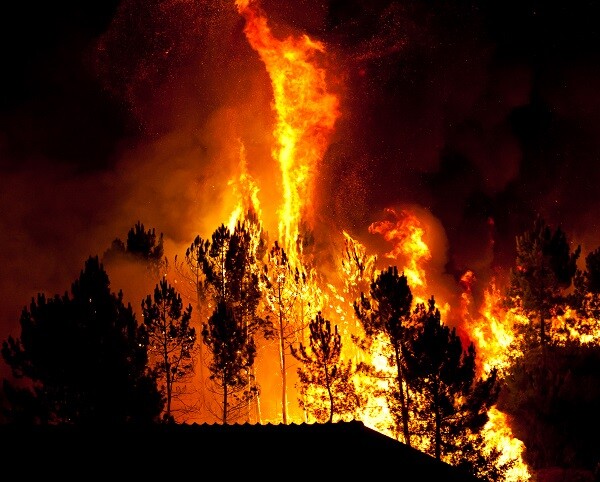
The prevention of wildfire damage to homes has become exceedingly more complex with rapid and pervasive climate change and the expansion of communities, even in Virginia. The good news is that there is plenty you can do as a homeowner to protect your home and property. The key to protecting your home from wildfire damage is having a defensible space.
What is a defensible space?
A defensible space is an adequate barrier around your home that is cleared of vegetation and other combustible fuels to reduce or prevent spread close to your home and other structures. It helps to protect firefighters defending your home. It can also work in the reverse function to prevent the chance of a home fire moving to the surrounding forest. Virginia’s forested areas are numerous and varied. The risk of wildland fire is always a possibility when living near this natural beauty.
A defensible space can also help protect your home from a neighbor's home fire. Kitchen fires are the most common cause of home fires. Home heating is the second highest cause, followed by electrical and intentional fires. Increasingly, rechargeable batteries are being linked to home fires due to product safety issues and a lack of public education about battery use and storage.
How can I protect my home from wildfire damage?
Reducing your risk of wildfire damage to your home is important. While home insurance does cover wildfire damage, creating a defensible space around your home is a simple and low-cost way to prevent this catastrophe. Depending on where you live in Virginia, it may also require more advanced planning and preparation. Your efforts depend on several factors beyond your home's location:
- Size and shape of buildings
- Materials used in their construction
- The slope of the ground on which the structures are built
- Surrounding topography
- Sizes and types of vegetation on the property
The Virginia Department of Forestry (VDOF) recommends maintaining at least 30 feet of lean, clean, and green space around your home. Let's break it down!
Lean space
The VDOF defines a "lean" space around your home as well-manicured and pruned trees and shrubs. Shrubs and tree branches should be at least 6 to 10 feet from the ground and free of dead wood. All vegetation should be pruned well away from the roof and 15 feet from a chimney.
Clean space
A clean space includes removing all dead plant material from around your home. Dry leaves, pine needles, dead tree limbs, stacked firewood, and flammable plants serve as the fuel for fires. Removing flammable plants is also recommended by the VDOF, such as hollies, ornamental junipers, red cedar, and young pines, because it protects your home from their flammable resins, oils, and waxes.
Green space
Creating a green space includes planting fire-resistant vegetation that is healthy and green throughout the year. Deciduous shrubs and trees burn with less intensity than evergreens and are a better choice to plant closer to your house. Less flammable plant choices are azaleas, viburnum, crape myrtles, spirea, hydrangea, annual and perennial flowers, ferns, dogwood, redbud, red maple and oak. The VDOF also suggests mowing and watering your lawn regularly can protect your property's defensive space. Keep your lawn green and cut short (3 inches) for 30 feet around your home.
Other ways to protect your home and property from wildfire damage
Once your defensible space is lean, clean, and green, take the following additional steps to protect your home from potential wildfire damage:
- Keep your gutters clean
- Move firewood piles out of your home’s defensible space
- Trim tree branches if they overhang your house or are within 20 feet of your chimney in case of a chimney fire.
- Avoid planting trees or shrubs along your driveway.
- Take care when grilling. Never leave your grill unattended while cooking.
- Plan, discuss, and drill an evacuation plan with your family, including your pets.
- Review your home insurance policy for adequate coverage. Consult your insurance agent about the current costs of rebuilding and repairs in your area.
- Talk to your children about avoiding playing with matches or starting fires.
- Check that motorized garden equipment, such as lawnmowers and chainsaws, has approved and functioning spark arrestors.
- Be sure to have highly visible house numbers on your home and at the driveway's entrance onto the street.
- Treat flammable materials like wood roofs, decks, and siding with fire-retardant chemicals.
- Inspect power lines on your property for close branches and ask the power company to clear any branches on or close to power lines.
- Pay attention to drought conditions in Virginia and take extra precautions.

Always extra take care when burning around your home:
- Consider composting leaves in the fall rather than burning them.
- Follow Virginia's Burn Law each year.
- Check the weather and local ordinances before burning your brush piles or grass.
- Hook up a hose and have a shovel handy before starting your burn pile.
- Avoid lighting fires or burning when high wind, high temperature, and low humidity are present or predicted or if the smoke and flames are blowing toward your or your neighbor’s home.
- Only dispose of ashes when they are completely cold and use a fireproof container.
Protecting your home and ensuring your home insurance adequately covers this primary asset is the best way to prepare for a wildfire in your Virginia community.
THE NORTHERN NECK INSURANCE INTEGRITY PROMISE — We pledge to provide straight talk and good counsel from our NNINS Virginia insurance experts through our blog. While we hope you find this to be a helpful source of information, it does not replace the guidance of a licensed insurance professional, nor does it modify the terms of your Northern Neck Insurance policy in any way. All insurance products are governed by the terms in the applicable insurance policy.


